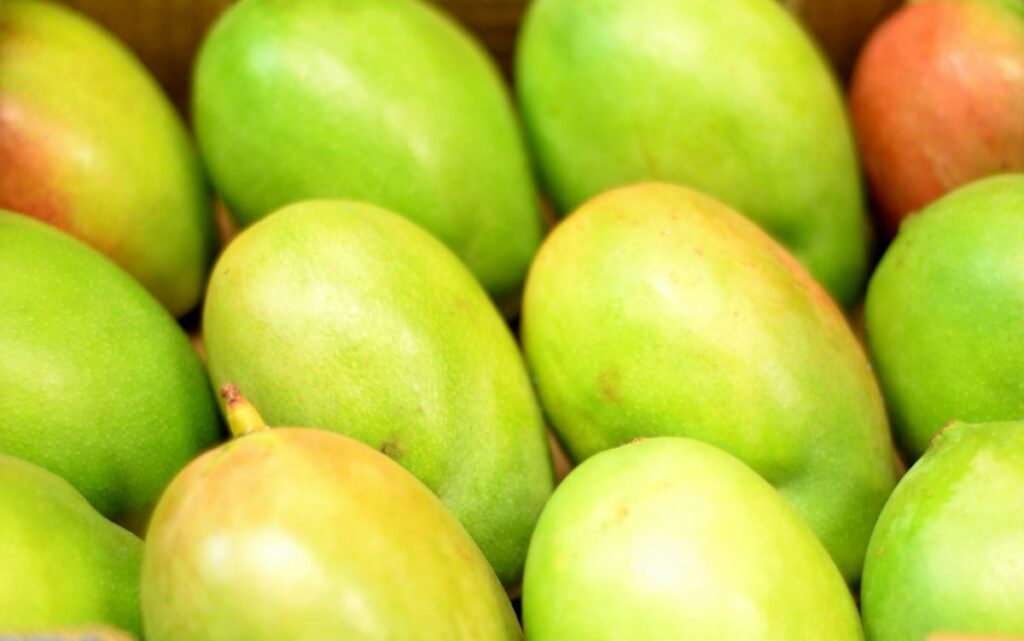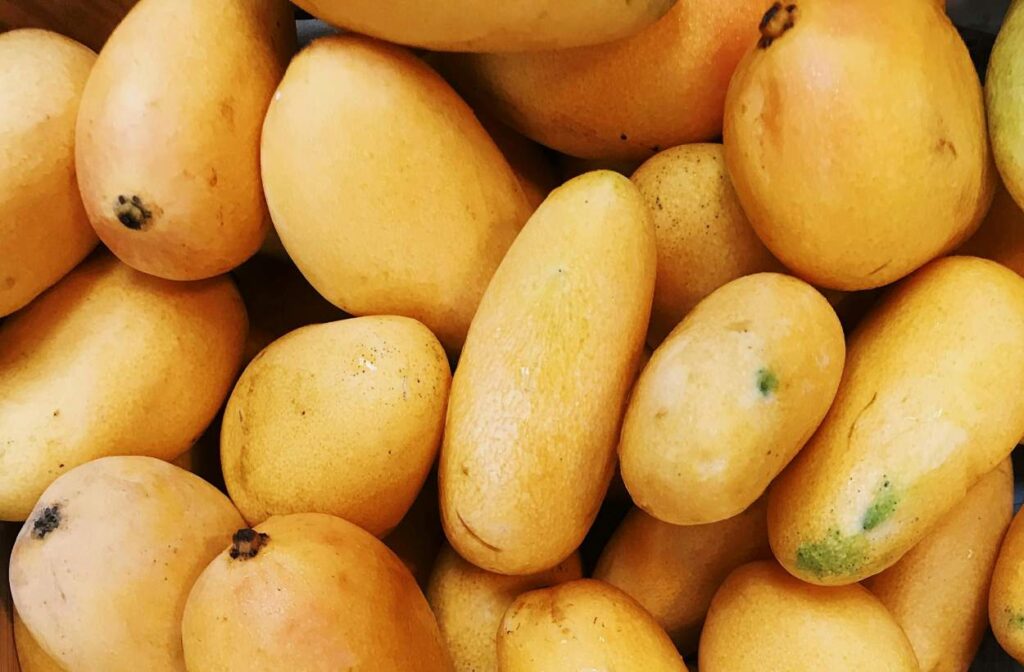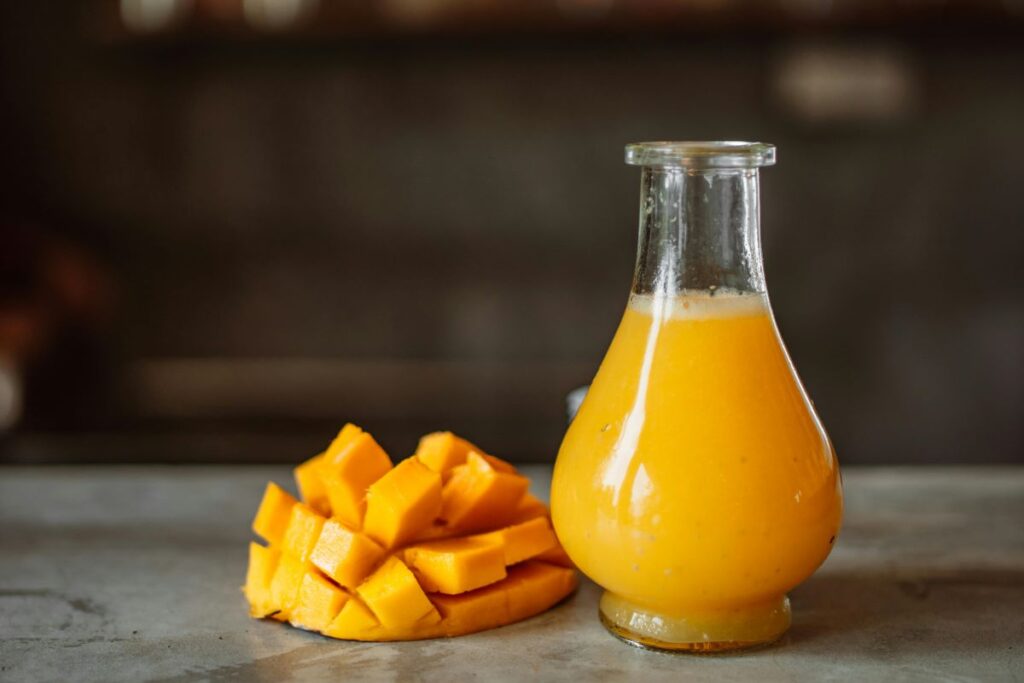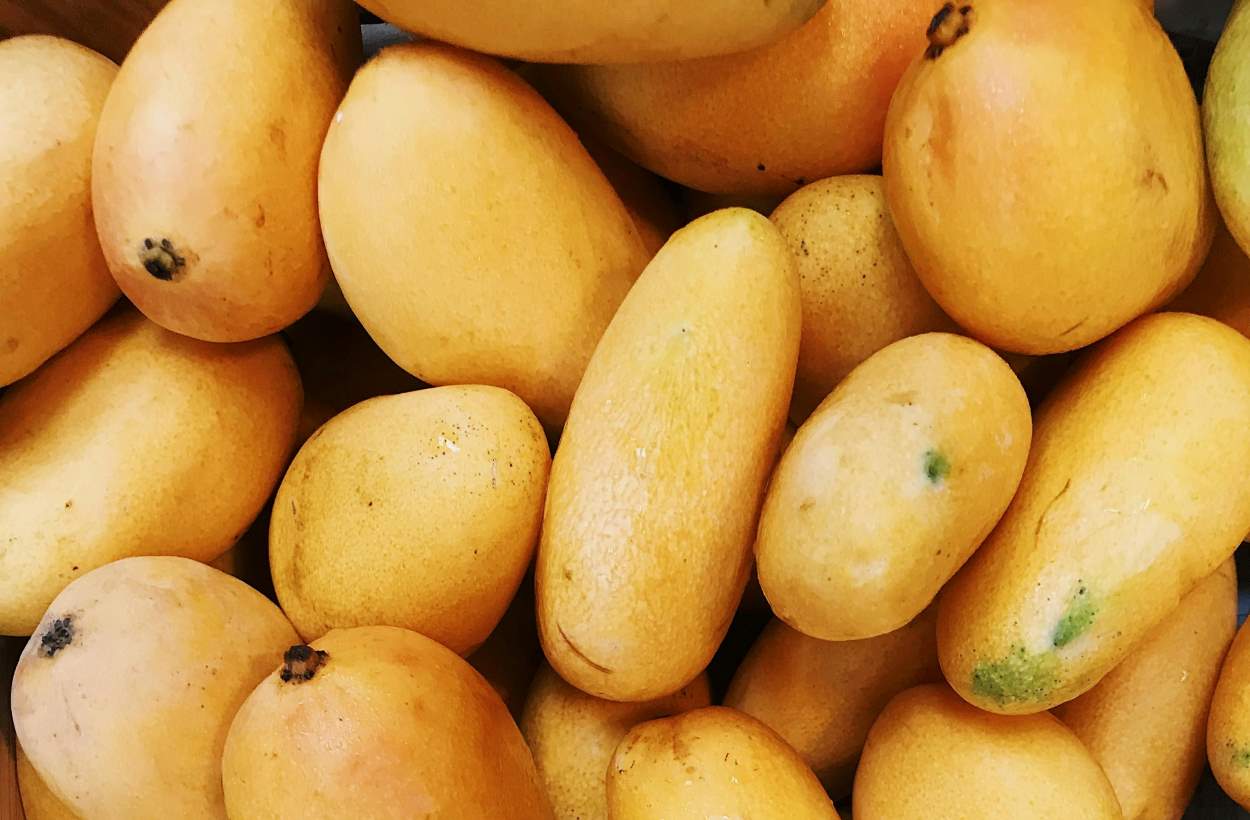Have you ever stood in front of a display of mangoes, unsure which one to choose? You’re not alone. Picking a ripe, sweet mango can feel like a mystery. But it doesn’t have to be.
I grew up in a house with mango trees in the yard. Every summer, we watched them grow from tiny buds to golden treasures. Now I want to share what I’ve learned about finding the best mangoes.
This guide will walk you through everything you need to know about mangoes. From how they grow to how to pick them. From how to cut them to how to use them in meals. By the end, you’ll shop for mangoes with total confidence.
Table of Contents
Why Mangoes Matter

Mangoes bring joy. Their sweet, tangy flesh can brighten any day. They pack loads of vitamins A and C. They help your body in many ways.
People all over the world love mangoes. They grow in over 100 countries. Each place has its own mango types and ways to eat them.
Mangoes connect us to the earth’s gifts. When you pick a good one, you take part in a tradition as old as time.
Also read,
- How to Tell if a Mango is Ripe: The Complete Guide.
- How to Cut a Mango: The Complete Guide.
The Life of a Mango
Mangoes start as small flowers on trees. These trees can grow very tall – up to 100 feet! They need warm weather all year. That’s why they grow in places like India, Mexico, and the Philippines.
After the flowers bloom, tiny green fruits form. Over weeks, these fruits grow bigger. They stay green for a long time. This helps them stay safe on the tree.
As they ripen, mangoes change color. They might turn yellow, red, or orange. Some stay a bit green even when ripe. It depends on the type of mango.
The mango tree works hard to make these fruits sweet. It pulls water from the soil. It takes energy from the sun. All to make the perfect fruit for us to enjoy.
Types of Mangoes You Might Find

Not all mangoes look the same. Here are some common types you might see:
Ataulfo mangoes are small and yellow. They have a thin pit and smooth flesh. Many call them “honey mangoes” for their sweet taste.
Tommy Atkins mangoes are large with red and green skin. They’re the most common type in US stores. They have a mild flavor and firm flesh.
Kent mangoes are large and green with red blush. They turn more yellow as they ripen. Their flesh is sweet with less fiber.
Keitt mangoes stay green even when ripe. They’re large with sweet flesh. They come late in the mango season.
Francis mangoes have bright yellow skin with some green. Their flesh tastes of sweet spice and is low in fiber.
Haden mangoes show red with green and yellow spots. They offer rich flavor with some fiber.
Each type has its own look, feel, and taste. Try different kinds to find your favorite.
When Are Mangoes in Season?
Mangoes grow year-round in different parts of the world. But each place has its own mango season.
In North America, most mangoes come from Mexico, Peru, Ecuador, and Brazil. The main season runs from May through September. But you can find some kind of mango in stores all year.
Local mangoes taste best. If you live where mangoes grow, watch for roadside stands during summer. These fresh-picked fruits beat any store-bought mango.
In places like Florida, mango season peaks in June and July. In Hawaii, you’ll find the best mangoes from May through October.
The season affects price too. Mangoes cost less during peak times. When they must travel far, prices go up.
The Art of Picking a Ripe Mango

Now for the main event – how to pick a perfect mango! Here’s what to look for:
Feel comes first. A ripe mango gives slightly when you press it gently. It should feel like pressing the tip of your nose. Not too firm, not too soft.
Smell matters. Sniff the stem end of the mango. A ripe one smells sweet and fruity. No smell often means no flavor.
Color can help. Most mangoes show red, yellow, or orange when ripe. But some stay green. Know which type you’re buying.
Look past looks. Small black spots on the skin are fine. They don’t hurt the flesh inside. Some of the tastiest mangoes look a bit ugly outside.
Check for heft. A good mango feels heavy for its size. This means it’s full of juice.
Avoid these signs: Skip mangoes with large soft spots, oozing juice, or sour smells. These show the fruit has gone bad.
Remember that some types of mangoes have different signs of ripeness. Ask the store staff if you’re not sure about a specific kind.
How to Ripen Mangoes at Home

What if you can only find firm, unripe mangoes? No problem. You can ripen them at home.
Put unripe mangoes in a paper bag. Close the top loosely. Leave the bag on your counter, not in the fridge. The mangoes will release a gas called ethylene. This gas helps fruits ripen. The paper bag traps the gas close to the fruit.
Check your mangoes each day. They should ripen in 1-5 days. How fast depends on how firm they were when you bought them.
Want to speed things up? Add a banana or apple to the bag. These fruits give off lots of ethylene gas.
Once mangoes feel ripe, you can put them in the fridge. This slows down the ripening. Ripe mangoes last about 5 days in the fridge.
How to Store Mangoes Properly
Where you keep your mangoes matters. Here’s how to store them:
Unripe mangoes go on the counter at room temp. Not in the sun. Not in the fridge. Cold temps stop the ripening process.
Ripe mangoes can stay on the counter if you’ll eat them in a day or two. For longer storage, put them in the fridge. This gives you about 5 more days to enjoy them.
Cut mangoes need to go in the fridge right away. Put them in a sealed container. Try to use them within 2-3 days.
You can freeze mango chunks for smoothies. Peel and cut the mango. Lay the pieces on a tray so they don’t touch. Freeze until solid. Then move them to a freezer bag. They’ll keep for months this way.
Dried mangoes last a long time. You can buy them or make your own with a food dryer. They make great snacks.
The Best Ways to Cut a Mango

Cutting a mango can seem hard at first. The large, flat pit gets in the way. But with the right method, it’s easy.
Try the “hedgehog” cut:
- Stand the mango on its stem end.
- Cut down about 1/4 inch from the center. The knife should pass just to the side of the pit.
- Do the same on the other side. Now you have two “cheeks” and a middle piece with the pit.
- Score each cheek with cuts that go through the flesh but not the skin. Make a grid pattern.
- Push the skin side so the cubes pop out. You can then cut them off or scoop them with a spoon.
For the middle piece, cut off what flesh you can around the pit.
Some people peel the mango first with a peeler. Then they cut the flesh off the pit. This works if your mango is firm.
Cut mangoes brown quickly. If you won’t eat them right away, add a splash of lime or lemon juice. This slows down the browning.
Mangoes Around the World
Mangoes play a big role in many food cultures. Here’s how people enjoy them:
In India (the world’s top mango grower), they make mango lassi. This sweet yogurt drink cools you on hot days. They also pickle green mangoes.
Thailand loves mango with sticky rice. The sweet fruit pairs with coconut-soaked rice for a perfect dessert.
Mexico puts mango on a stick. They cut it in a flower shape and add chili powder and lime.
The Philippines makes mango ice cream and smoothies. They also eat green mangoes with salt or shrimp paste.
Jamaica makes mango chutney. This sweet-sour-spicy spread goes with many dishes.
In Brazil, they blend mangoes into juice or use them in tropical fruit salads.
Each culture finds its own way to honor this gift of nature.
Health Benefits of Mangoes
Mangoes don’t just taste good. They do good things for your body too:
They give you lots of vitamin C. One mango has all you need for a day. This helps your immune system.
They’re full of vitamin A. This keeps your eyes and skin healthy.
Mangoes have fiber. This helps your digestion work well.
They offer antioxidants. These fight damage in your body’s cells.
The enzymes in mangoes can help digest protein. Some people eat mango after a big meal for this reason.
Studies link mangoes to better blood sugar levels. They may help fight some health issues.
Of course, mangoes also have sugar. Enjoy them as part of a mix of many fruits and foods.
Common Mango Mistakes to Avoid
Even mango lovers make mistakes. Here are some to watch for:
Not giving them time to ripen. Many people eat mangoes too soon. A firm, sour mango brings little joy. Let them soften up!
Using just one test for ripeness. Don’t just look at color. Feel and smell too. All three help you find a good mango.
Keeping them too cold too soon. Unripe mangoes won’t ripen in the fridge. Let them ripen at room temp first.
Cutting them wrong. Fighting with the pit makes a mess. Learn the “hedgehog” cut for clean, easy cubes.
Ignoring the type. Different mango types have different signs when ripe. Learn about the kind you buy.
Throwing away less pretty mangoes. Some of the sweetest mangoes look spotted or odd on the outside. Don’t judge by looks alone.
Fix these common errors and you’ll enjoy better mangoes every time.
Beyond Fresh: Other Ways to Buy Mangoes
Fresh isn’t the only way to enjoy mangoes. Try these forms too:
Frozen mango chunks work great in smoothies. They’re cut and peeled for you. Look in your store’s freezer section.
Dried mangoes make good snacks. Check that they don’t have too much added sugar.
Mango nectar or juice lets you drink your mangoes. Again, watch for added sugar.
Canned mangoes last a long time. They work well in baking.
Mango products like chutney, salsa, or jam bring mango flavor to meals.
If fresh mangoes aren’t in season or cost too much, these options can satisfy your mango cravings.
Cooking with Mangoes

Mangoes shine in many dishes. Try these ideas:
- Mango Salsa: Mix diced mango with red onion, cilantro, jalapeño, and lime juice. Serve with chips or on fish or chicken.
- Mango Smoothie: Blend mango chunks with yogurt, a banana, and a touch of honey.
- Mango Chicken: Add mango pieces to stir-fry chicken with bell peppers and onions.
- Mango Rice: Mix mango chunks into rice with coconut milk and a pinch of salt.
- Mango Desserts: Use mangoes in ice cream, pie, or cobbler.
- Mango Drinks: Add mango to cocktails, tea, or water for flavor.
The sweet-tart flavor of mangoes works in both sweet and savory dishes. Let your taste buds guide you.
Growing Your Own Mango Tree
If you live in a warm place, you might try growing a mango tree. Here are some tips:
Start with a dwarf variety if you have limited space. These grow 4-8 feet tall instead of 100 feet.
Plant your tree in full sun. Mangoes need at least 6 hours of sun each day.
Use well-draining soil. Mangoes don’t like wet feet.
Water deeply but not too often. Let the soil dry between waterings.
Protect young trees from cold. Even a brief frost can kill them.
Be patient. Trees grown from seed take 5-8 years to make fruit. Grafted trees fruit sooner.
Know that indoor mango trees rarely fruit. They need the right climate and insects for pollination.
Growing mangoes takes work, but the reward of your own tree’s fruit makes it worth it.
Mango Facts to Impress Your Friends
Love mangoes? Share these fun facts:
Mangoes belong to the same plant family as cashews and pistachios.
The world grows over 500 types of mangoes.
India grows the most mangoes – about half of all mangoes on Earth.
Mango trees can live 300 years and still bear fruit.
The mango is the national fruit of India, Pakistan, and the Philippines.
Mangoes have been grown for over 5,000 years.
The name “mango” comes from the Malayalam word “manna.”
Each mango tree can grow hundreds of fruits in a season.
These facts show just how special mangoes are in our world.
Final Thoughts on Picking the Perfect Mango
Picking mangoes gets easier with practice. Soon you’ll spot good ones at a glance.
Remember the key steps:
- Feel for slight softness
- Sniff for sweet smell
- Consider the type
- Look past small flaws
- Give them time to ripen if needed
Each mango offers a small taste of sunshine. A gift from nature that spans cultures and brings joy.
The next time you hold a mango, think of its journey. From a flower on a tall tree to your kitchen. From green firmness to sweet ripeness. It’s a small miracle in your hand.
So go ahead – pick a mango today. Use what you’ve learned to find a good one. Then slice it open and enjoy the reward of your new mango-picking skills.
Happy mango hunting!

